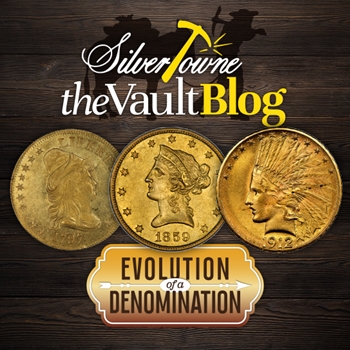
The Act of April 2, 1792, authorized several coins after the Revolutionary War with the intent of a new monetary system for the United States. Only a few became top priority for the new nation, including the primary gold coin that would face the rest of the world.
Capped Bust to Right (1795-1804)
Established as the “eagle” after the United States’ national bird, the $10 gold coin first made its appearance in the Fall of 1795. Along with the half eagle that was debuted less than two months earlier, the gold coin was designed by Chief Engraver Robert Scot. The design features Liberty wearing a cap facing right with LIBERTY inscribed above with the date seen below her. During the first years of the coin, there were fifteen stars on either side. The reverse design depicts an eagle with widespread wings atop a branch with a wreath in its beak. UNITED STATES OF AMERICA is seen along the outer edges of the coin.
From 1795-1797, the reverse featured the Small Eagle variety, with 1797-1804 dates depicting the Heraldic Eagle. In addition, the coins also were changed to feature reverse stars above the eagle instead of the wreath from the beginning years. Regardless of the design, the eagle never really took off like it was hoped it would in serving as the nation’s predominant gold coin for international trade. The public, including the banks, preferred the half eagle as it was smaller and similar in size to other widely used and highly recognized coins throughout the world. These included the British guineas and sovereigns, the French 24 Livres, and the Brazilian 4000 Reis.
Another reason the coin did not take off was that the price of gold rose in response to the Napoleonic Wars. The unused and undervalued gold United States coins would perish into melting pots. They would see little circulation, so many surviving early eagle coins are found in relatively higher grades than suspected. Over 132,000 gold eagles were struck from 1795-1804 with Scot’s design, a majority of which featured the Heraldic Eagle reverse.
Liberty Head (1838-1907)
As the “Reign of Terror” and the Napoleonic Wars uprooted gold prices, the United States Mint found themselves backed into a corner as the weight specifications and 15 to 1 silver/gold ratio was bound by the Coinage Act of 1792. The market fluctuations would be catastrophic on United States coinage and more specifically the $10 gold eagle. Bullion would get swept from the markets internationally, leaving the United States gold coins rendered worthless. By 1813, 98% of all United States gold coins would be destroyed. It was in 1804 though that President Thomas Jefferson would order the halt in production of the eagle. That is until 34 years later in 1838 when the minting continued.
It took two different Congressional Acts for gold coins to get the go ahead as the weight and fineness were adjusted enough for them to continue in circulation. Acting Chief Engraver Christian Gobrecht, who replaced a sickly William Kneass, was instructed to prepare dies for the new design. In Gobrecht’s new design, Liberty is facing left wearing a coronet inscribed with the word LIBERTY. Her hair is gathered in the back with hanging curls has thirteen stars are seen around the outer edge. The date is featured below her. The reverse depicts an eagle holding an olive branch and arrows. UNITED STATES OF AMERICA and TEN D. are inscribed around the edges and the mint marks were featured just below the eagle.
The first coins of 1838 and 1839 are different than the remaining issues as Gobrecht would rework the obverse design to feature the bust of Liberty more centered over the date. In its very first year, the Mint produced 7,200 gold eagles. Over the series, the $10 eagles would remain unchanged until the addition of the motto in 1866. It was featured above the eagle from 1866-1907 when the series ended.
Indian Head (1907-1933)
The design of the $10 gold eagle would change not only with the turn of the century, but with the push for more stunning and updated looks as led by none other than Teddy Roosevelt. In collaboration with Augustus Saint Gaudens, the new gold coins, including the eagle, were artistic and undeniably innovative.
The $10 coin featured a bust almost identical to the Nike head (Victory) that Saint Gaudens designed for the monument seen in New York’s Central Park. Liberty would wear an Indian feathered bonnet with the word LIBERY inscribed on her headdress. Thirteen stars are above her head and the date below her. The reverse depicts an eagle standing on a bundle of arrows with the motto E PLURIBUS UNUM seen on its right. UNITED STATES OF AMERICA is curved along the top arc of the design while the denomination TEN DOLLARS can be seen below it.
First struck in 1907 were the Wire Edge pieces which mean that there was no raised edge that traditionally were seen on United States coins. Five hundred of these were produced with 46 raised stars on the edge to symbolize how many states there were at the time. However, the wire edges were eventually seen as nonfunctional as the coins would not stack. This caused the Mint to strike the next batch of 1907-dated coins with the Rolled Edge which brought back the raised rims as previously used before on all coins. Over 31,000 of those were struck that year and continued to be struck through 1908 until the reverse would see another change. The motto IN GOD WE TRUST was added in 1908, resulting in two different varieties of the $10 Gold Indian to emerge that year. The Motto on the Reverse would continue to be the standard moving forward throughout the series until its end in 1933.
While the series officially ended in 1933, the coins were sporadic as subsequent dates would follow all the way until 1916 but not continue again until 1920. That pattern continued through the 1920s and into the 1930s until the Mint would strike its last batch of 312,500 Indian Head gold coins in 1933. Although struck, the Mint would only release a few dozen of those coins before President Franklin D. Roosevelt ordered the end of circulation of gold coins and notes. Most of the eagles were melted back down to .900 fine gold. The $10 Indian Head Eagles, along with hundreds of thousands of other historic gold coins, would be melted down and wiped from existence.
Source: NGC Coin; The Official 2025 Red Book







